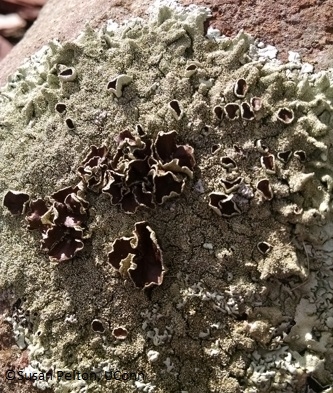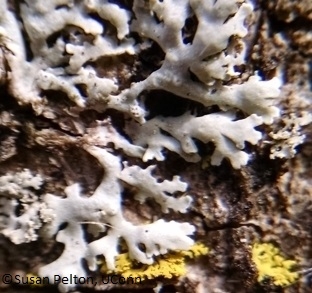Lichen
 Lichen are composite organisms and although they sometimes appear plant-like, they are not plants. They have algae (or cyanobacteria, a name that reflects their blue-green hues) that live among the filaments of fungi in a symbiotic relationship. The algal part is a phycobiont, an alga in association with another type of organism, and the fungal part is a mycobiont, a mycorrhizal fungus in association with another type of organism. The algae provide the color component of lichen and the fungi provide the structural component.
Lichen are composite organisms and although they sometimes appear plant-like, they are not plants. They have algae (or cyanobacteria, a name that reflects their blue-green hues) that live among the filaments of fungi in a symbiotic relationship. The algal part is a phycobiont, an alga in association with another type of organism, and the fungal part is a mycobiont, a mycorrhizal fungus in association with another type of organism. The algae provide the color component of lichen and the fungi provide the structural component.
Lichen live symbiotically with host plants, on soil and on rocks. They do not have roots to absorb water and nutrients but they can produce food through photosynthesis by the algae component. Lichen are sometimes called moss and may grow amongst them but they are not related. They can be correctly called an epiphyte though. Epiphytes grow harmlessly on other plants, only relying on the physical support for its structure and getting moisture and nutrients from the air and rain.
The appearance of lichen often leads to the misconception that they must be causing harm to the host plant, especially since they are commonly first noticed when a tree is in distress. But a sparse canopy simply lets in more sunlight which is advantageous to the lichen.
Lichen may be a benefit to the host plant by bringing extra moisture and environmental protection as the lichen take root. Further, removal of lichen may damage the underlying bark may create open wounds that would allow pathogens to enter. Since lichen absorb most of their water and nutrients from the atmosphere they are considered bio-indicators and can be used to track air pollution.
Lichen can reproduce in two ways. One way is they may produce soredia, a cluster of algal cells wrapped in fungal filaments that will disperse and form new lichen. Another is through isidia, a structure like the soredia except that it is enclosed within a protective layer of cortex tissue and resembles a miniature lichen.
Lichen are long-lived but can have slow growth rate, as little as 2/100” in a year although there are varieties that can measured at 1 ½’ per anum. Lichen can be the first species to colonize freshly exposed rocks and can survive under the harshest conditions, such as arctic tundra and desert. It can survive a complete loss of water and then rehydrate when water becomes available. Even dried pieces that break off can rehydrate into new lichen.
As lichen grow the forms that the thallus take determine the grouping that they fall within. The thallus are the obvious vegetative body parts and they can grow in a variety of ways and colors. Lichen species can exhibit overlapping growth types.
- Byssoid-a wispy growth form that is compared to the look of teased wool or cotton.
- Crustose-forms a difficult to remove hard crust.
- Filamentous-forms a mass of thin, stringy filaments.
- Foliose-flat, leaf-like lobes.
- Fruticose-grows in tufts of branched shrubs or hangs down in tassels.
- Gelatinous-Jelly-like masses.
- Leprose-Powdery or granular surface.
- Structureless

Caloplaca sp., crustose growth form

Parmotrema sp., foliose growth form
If the host plant does seem to be in decline, look for another cause. It could be due to an insect infestation such as a canopy defoliation by Gypsy Moth caterpillars, a vascular disease that has caused a general decline in vigor, or uneven watering practices. Check with the UConn Home & Garden Education Center for verification of any of these possibilities.
For pesticide information or other questions please call toll free: 877-486-6271.
UConn Home and Garden Education Center, 2017
Issued in furtherance of Cooperative Extension work, Acts of May 8 and June 30, 1914, in cooperation with the U.S. Department of Agriculture, the Dean of the College, Cooperative Extension System, University of Connecticut, Storrs. The Connecticut Cooperative Extension System is an equal opportunity employer and program provider. To file a complaint of discrimination, write USDA, Director, Office of Civil Rights, Room 326-W, Whitten Building, Stop Code 9410, 1400 Independence Avenue, SW, Washington, DC 20250-9410 or call (202) 720-5964.